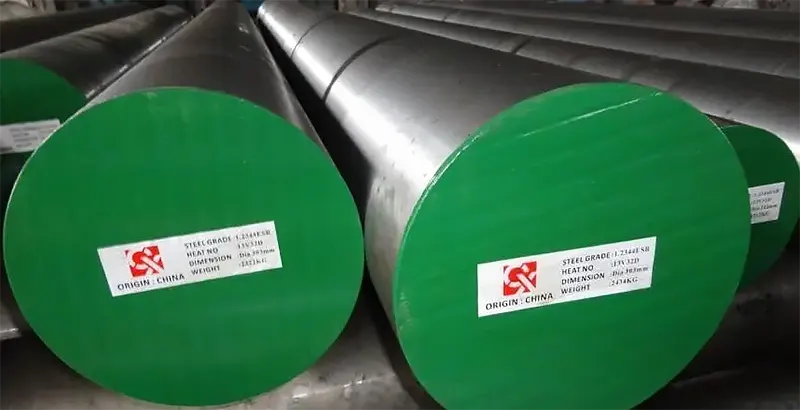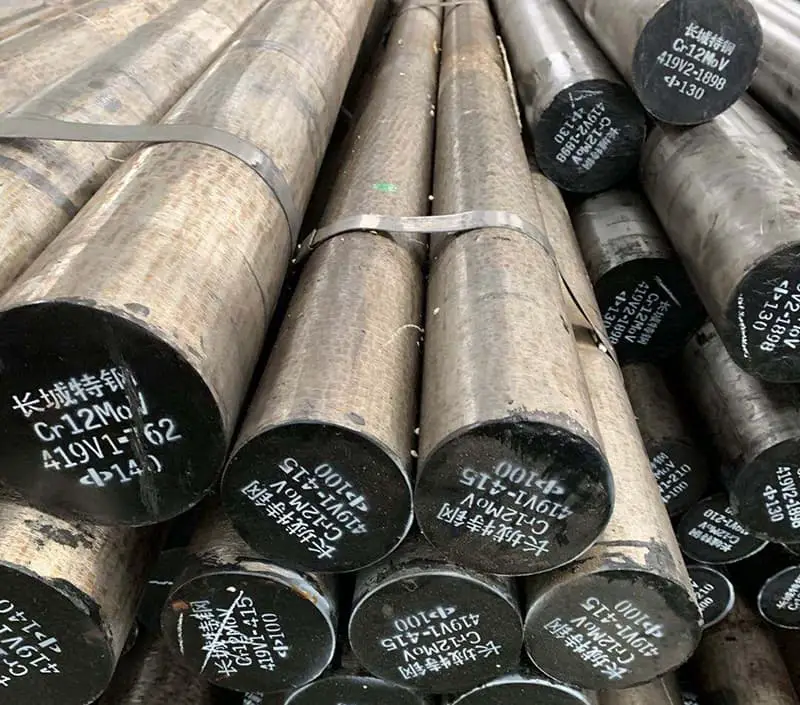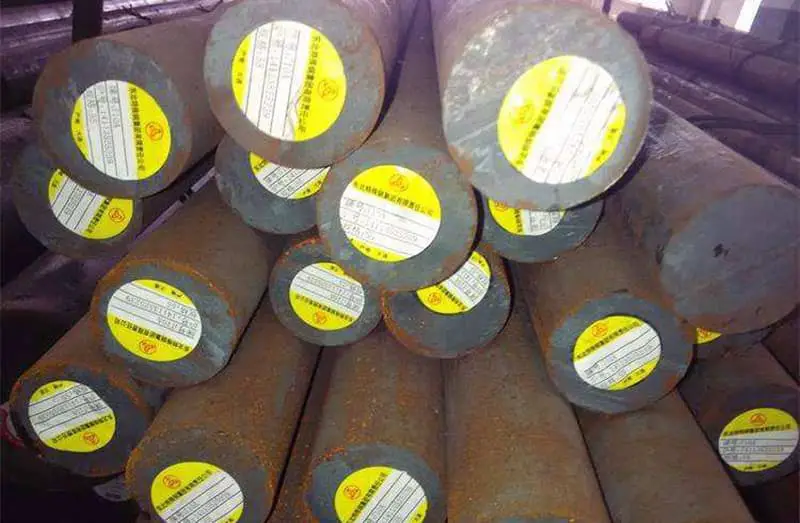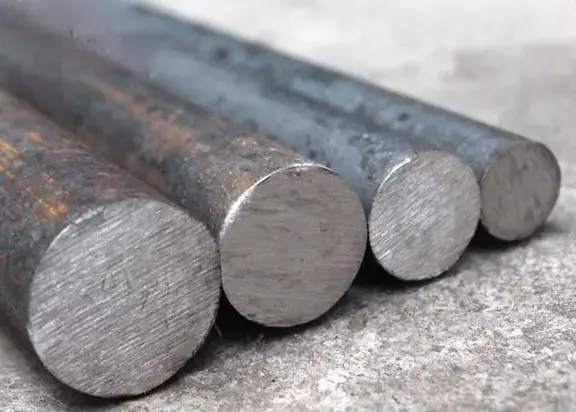1. LD Cold Work Steel Mold (7Cr7Mo2V2Si)

Features and application:
LD (7Cr7Mo2V2Si) is a tough, high-quality cold work die steel that was initially developed for cold heading dies. Its code, “cold header,” reflects its usage.
In actual production, LD steel is used to manufacture cold heading, cold extrusion and cold die tools that require high toughness. It has better performance than Cr12 and W6Mo5Cr4V2.
LD steel is a die-type code mold steel, characterized by high strength and wear resistance, high bending strength, excellent cold and hot processing technology, minimal heat treatment distortion and versatility.
With its superior strength and toughness, good wear resistance and the ability to manufacture a variety of cold cutting scissor blades, LD steel has a longer service life, more than ten times that of other materials such as Cr12MoV, W18Cr4V, W6Mo5Cr4V2, Cr12, GCr15 and 9SiCr.
Mechanical properties:
- Blade hardness: HR57 ~ 63
Heat treatment specifications:
- Quenching temperature 1100 ~ 1150 ℃, quenching temperature 530 ~ 540 ℃
2. H13 (4Cr5MoSiV1) hot work steel mold

Features and application:
H13 steel (4Cr5MoSiV1) is a high-quality air-hardened die steel with excellent toughness and hot and cold fatigue resistance. It is not prone to thermal fatigue cracking, has strong anti-adhesion properties and experiences minimal interaction with molten metal, making it widely used in the manufacture of blades for hot upsetting, hot extrusion and thermal shearing machines.
In terms of performance, H13 steel is similar to 4Cr5MoSiV steel, but its high vanadium content provides superior temperature performance (up to 600 degrees) compared to 4Cr5MoSiV steel.
It is a representative steel used in hot work steel molds and is suitable for hot shearing of steel plates at temperatures below 800°C.
Mechanical properties:
- Blade hardness: HR56 ~ 58
Heat treatment specification:
- quenching temperature 1050 ~ 1080 ℃, quenching temperature 530 ~ 560 ℃
3. 6CrW2Si alloy tool steel

Features and application:
6CrW2Si is a high-quality tool steel alloy made by adding a certain amount of tungsten to chrome-silicon steel. The addition of tungsten results in finer grains during quenching, leading to increased toughness under tempering conditions.
When compared to 4CrW2Si steel and 5CrW2Si steel, 6CrW2Si steel has higher quenching hardness and better high temperature resistance. This type of steel is commonly used to produce hydraulic shear blades that need to withstand impact loads and high wear resistance. It can be used to cut common steel and hard-textured stainless steel plates.
Mechanical properties:
- Blade hardness: HRC56 ~ 60
Heat treatment specification:
- Quenching temperature 860 ~ 900 ℃, quenching temperature 285 ~ 229 ℃
4. High Speed Tool Steel W6Mo5Cr4V2

Features and application:
W6Mo5Cr4V2 is a high-quality, high-speed tool steel, also known as 6542, commonly referred to as “high-speed steel”. It is a high-carbon, high-alloy tool steel designed for high-speed cutting.
The tungsten-molybdenum series is a representation of high-speed steel, with high hardness, wear resistance and thermal hardness (also known as red hardness). At temperatures up to 500 to 600 degrees Celsius, the hardness of the cutting tool does not decrease significantly.
Compared to W18Cr4V, W6Mo5Cr4V2 has similar high temperature hardness, but is more prone to oxidation and decarburization, so it should be handled carefully during heat processing and heat treatment.
This steel can be cut at higher speeds than low-alloy cutting tool steel, making it ideal for blades that require high cutting speeds, heavy loads and high working temperatures. It is suitable for sheet metal cutting in various conditions.
Mechanical properties:
- Blade hardness: HR62 ~ 68
Heat treatment specifications:
- Quenching temperature 1210 ~ 1230, quenching temperature 540 ~ 560
5. Cr12MoV die steel

Features and application:
Cr12MoV is a high-quality mold steel that has greater hardenability, hardness after quenching and tempering, strength and toughness than CR12. It is capable of completely hardening to diameters below 300 to 400 mm, with minimal quenching deformation. However, it has low plasticity at high temperatures.
Cr12MoV is mainly used to produce hydraulic shear blades with larger cross sections, complex shapes and heavy workloads. The blade made of Cr12MoV can be used to cut more than 800,000 times and is suitable for cutting high hardness plates such as stainless steel and silicon steel sheets.
Mechanical properties:
- Blade hardness: HRC56 ~ 60
Heat treatment specifications:
- Quenching temperature 950 ~ 1000 ℃, quenching temperature 200 ℃ ~ 250 ℃
6. 9CrSi alloy tool steel

Features and application:
9CrSi is a high-quality, low-speed, low-alloy cutting tool steel known for its brittleness and hardness, as well as its tendency to exhibit heat sensitivity, which leads to surface hardening and an increased risk of cracking. .
It is a low-alloy tool steel commonly used in measuring and cutting tools, featuring high hardenability and hardenability and stability during tempering.
9CrSi can be used to manufacture hydraulic shear blades with complex shape, minimal deformation, high wear resistance and low speed cutting ability.
It is ideal for cutting common A3 and Q235 boards.
Mechanical properties:
- Blade hardness: HRC55 ~ 58
Heat treatment specifications:
- Quenching temperature 820 ~ 860 ℃, quenching temperature 180 ~ 200 ℃
7. T10A carbon tool steel

Features and application:
T10A is a high-quality carbon structural steel with high strength and wear resistance, but low hot hardness, temperability and hardenability, and high quenching deformation. It is suitable for manufacturing shear blades in poor cutting conditions, with high wear resistance requirements and not subject to sudden and severe vibrations, requiring a certain level of toughness and sharp knife edge. It is used to cut common A3 sheets.
Mechanical properties:
- Blade hardness: HRC52 ~ 55
Heat treatment specifications:
- Quenching temperature 770 degrees, quenching temperature 200 degrees
8. 45# carbon structural steel

Features and application:
45# is a high-quality carbon structural steel widely used in machine manufacturing. It has good cutting characteristics and mechanical properties.
However, as a medium carbon steel, 45# steel has poor hardening performance and is not suitable for use in manufacturing sheet metal cutting machine blades. Its heat treatment hardness is only between HRC 42-46, so the typical approach is to use a combination of quenching and tempering and high-frequency surface quenching. The wear resistance is slightly worse than that of carburizing, making it suitable for cutting non-metallic sheets.
Mechanical properties:
- Blade hardness: HRC42 ~ 56
Heat treatment specifications:
- Quenching temperature 840 degrees, quenching temperature 300 degrees

























































